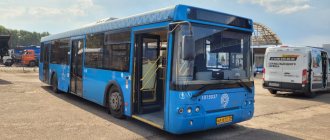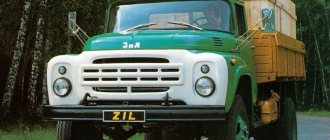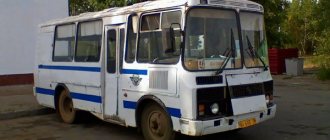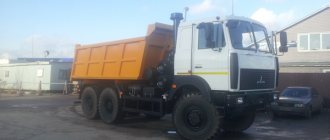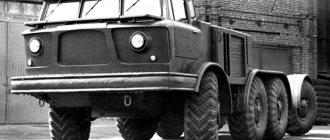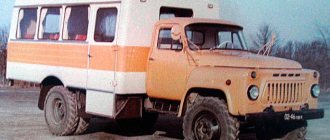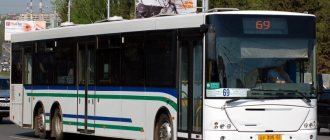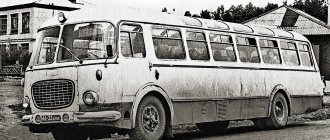BUS FRONT AXLE PAZ-32053
Adjusting the toe-in of the wheels of the PAZ-32053 bus
1. Place the bus on a horizontal platform. Set the front wheels to a straight-ahead position. Check the tire pressure and, if necessary, adjust it to normal;
2. Between the inner edges of the wheel tires (at a diameter of (730.740) mm) in front of the front axle, insert a sliding ruler parallel to the platform at the height of the wheel axle axis.
3. Take a measurement, marking the installation location of the ruler.
4. Roll the bus forward 1/2 turn of the wheel and, placing a ruler at the marks behind the front axle, take measurements. If the difference in measurements does not fall within the limits of (2.4) mm, then adjustment must be made.
Wheel alignment is adjusted by changing the length of the tie rod.
5. Loosen the coupling bolts of both ends of the transverse link and, by rotating it with a pipe wrench, achieve the required amount of wheel toe. After adjustment, secure the tie rod end bolts.
The change in the length of the transverse steering rod occurs due to: – different thread pitches at the ends of the rod (on the left - 1.5 mm, on the right - 2 mm) at the front axle manufactured by JSC KAAZ; – different thread directions at the ends of the rods at the front axle produced by Ryazan-Avtoagregat LLC. If to establish wheel alignment of the axle of JSC KA-AZ, a change in the rod length is required by more than
5 mm, then remove the transverse link from the bus and set the required length by moving the left and right ends the same way. Then make final adjustments as indicated above.
- Fast and accurate diagnosis
- Highly qualified repairs and maintenance
- Prices are below the market - 1300 rubles. working hour
- Quality assurance
Request a call back and we will contact you as soon as possible
Characteristics of groove bus tires
PAZ-32053-07 and PAZ-4234.
WHEELS AND TIRES The Class II bus has disc wheels with a rim size of 6.0×20. The bead ring is split. Disc stamped, unrolled; connected to the rim by welding.
The tires of the PAZ-32053-07 bus (II class) are tube tires with a size of 8.25R20 (240Rx508). The ply rating (load capacity) is 12, indicated on the side surface of the tire with an index - 130/128K or 130/128J.
The tires of the PAZ-4234 bus (II class) have the same dimensions as those of the PAZ-32053-07, but due to the increased load on the bridges they differ in ply rating (load capacity). In this connection, it is recommended to use tires with a ply rating of 14, which is indicated on the side surface of the tire with the index -133/131K (NS 14).
Attention! The use of tires with a load index less than recommended can lead to increased wear (reduced service life) or damage to the tire while driving with subsequent loss of controllability of the bus.
Class I buses are equipped with disc wheels with a rim size of 6.75×19.5 without a bead ring. The stamped disc is connected to the rim by welding and attached to the hub with studs.
Class I bus tires are tubeless, low-profile, radial. Tire size 245/70 R19.5.
Typical wheel malfunctions are increased runout, wear of the central hole of the disk, bent rim and bead ring. Radial and lateral runout of the wheel should not exceed 3 mm. If the runout is greater, then the wheel must be replaced. Increased runout can lead to wheel bearing failure and premature tire wear.
Wear of the central hole of the wheel disk (“PAA”) or holes in the disk for mounting studs (“KAAZ”) occurs due to weak tightening of the wheel nuts. It is necessary to periodically check the tightness of the wheel nuts.
Attention! After removing and installing the wheels, it is necessary to check the tightness of the wheel nuts every (100-150) km. If no looseness is observed during the inspection, subsequent inspections are carried out during scheduled maintenance. Wheel nut tightening torque: for "RAA" - (390.490) Nm, for "KAAZ" - (315.390) Nm.
A bent bead is usually caused by improper disassembly or assembly of the wheel and tire. A bent or dented bead ring must be repaired or replaced with a new one. It must be remembered that when the tire is inflated with air, a bead ring whose configuration is incorrect can jump out of the rim lock groove and injure others.
Wheel replacement is carried out in the following sequence:
1. Loosen the wheel nuts and jack up the wheel.
2. Unscrew the wheel nuts and remove the wheel from the hub.
3. Clean the hub and drum from dirt and install the wheel on the hub. Tighten the nuts just enough to hold the wheel firmly in place. Tighten the wheel nuts crosswise, gradually and alternately so that the wheel is evenly pressed against the drum flange.
Source
Adjusting the toe angles of trucks and buses
Quality repairs and service at a reasonable price!
Correctly positioned wheels and axles allow you to control the cost of truck mileage. Adjusting wheel alignment angles and axle positions leads to significant savings on fuel and tire wear. Fuel costs can be reduced by 5-10%, and the service life of a set of tires can be increased by up to 80%.
Adjusting the toe angle of truck wheels is necessary if:
- the car has passed the next 10-15 thousand km
- the chassis was repaired
- new tires installed
- structural work has been completed to change the ground clearance
- The car pulls to the right or left when driving
- The steering wheel has changed its neutral position
- tire wear has increased noticeably or is uneven
- the car does not hold the road well or is thrown to the side
- fuel consumption increases
All axles and wheels mounted on the load-bearing frame of a truck affect each other in motion and must be adjusted, including those installed on trailers and semi-trailers. Any distortion of the frame (bending, displacement, torsion) has a negative impact on the behavior of the vehicle on the road. Even if the tractor is perfectly adjusted, a poorly adjusted semitrailer will affect the truck's movement, causing difficulty in handling and increasing the risk of accidents.
At the GRUZSERVICE service station you can carry out precise adjustment of the toe angles of the wheels of any brands of trucks and buses. Here you will be met by highly qualified specialists who are familiar with the specifics of each individual car brand and its design features. Our technicians will help you quickly and accurately identify faults and eliminate them, and also provide useful recommendations for servicing and caring for your car.
Main tire sizes for PAZ equipment
Due to difficult operating conditions and heavy daily loads, PAZ buses are predominantly equipped with all-season tires. This type of tire neutralizes the negative sensations when driving over bumps, holes and potholes. Makes it possible to quickly move along intracity and adjacent regional highways.
Main tire sizes for PAZ equipment
There are four positions among the most popular tire sizes for regular buses:
- 8.25R20 (240R508) – full-profile all-season truck tires on the groove with excellent traction ability. Intensively removes heat from the critical heat-generating zone of the tire. Improves handling, facilitates maneuvering and ensures uniform tread wear. Softens shocks and shocks when moving over uneven, poor-quality and broken road surfaces;
- 245/70R19.5 – radial tire with a non-directional pattern and good performance properties;
- 235/75R17.5 – all-season radial tires with a narrower tread. Does not create excessive background noise during movement.
Tires for PAZ
Every driver, whether professional or amateur, approaches the issue of choosing wheels for a car very carefully, wanting to achieve good tire grip on the road and ensure the safety of himself and his passengers. When selecting tires for PAZ, as well as for other trucks, it is necessary to take into account the operating conditions of the vehicle, as well as the load index, tread structure and other characteristics of the tires.
Tire manufacturers have provided their consumers with a unique opportunity - a choice that is quite rich today. One of the leaders in the tire industry is the Nizhnekamsk manufacturer.
The range of this manufacturer and the Altai Tire Plant for PAZ vehicles includes the K-84 (U2) tube tire model, which has excellent performance and a long service life. All these properties are complemented by a fairly attractive price. The tread pattern of this model is symmetrical and non-directional, which allows the tire to be used on a variety of road surfaces throughout the year. Also on its surface there are four longitudinal ribs, each consisting of a number of free-standing massive blocks, including shoulder areas. In the center of the tire there are polygonal tread blocks; they are located at a small distance in relation to each other, which allows for uniform load distribution. The shoulder areas of the tire are reinforced and equipped with additional rows of powerful lugs, which increases the tire's maneuverability and protects it from minor damage.
Altaishina-79 is another model from the Altai manufacturer for PAZ cars. The tread of this model consists of four longitudinal ribs, which are separated by stepped zigzag grooves. This tire holds the road well in different weather conditions and also has a high level of wear resistance.
In addition, the PAZ bus can be “shod” with imported tires. TRIANGLE bus tires have a deep tread pattern for durability. Deep transverse and longitudinal grooves on the tread help improve steering and braking characteristics. This pattern and extended sidewall protects the tire from minor punctures and cuts.
The number of models of tires of different brands for PAZ cars is very diverse; set the tire search parameters in our online store and purchase tires for PAZ with the characteristics you are interested in.
Review of tires for PAZ buses
Publication date: 07/20/2021
Special requirements are imposed on the equipment and condition of vehicles used for urban and suburban passenger transportation. The process of choosing tires for PAZ buses requires special attention. This is due to the fact that not only passenger safety and fuel economy, but also driving performance (braking and acceleration, stability on wet or icy roads) depend on the quality and characteristics of tires.
It may seem that there is nothing simpler than replacing worn PAZ tires with a new analogue. However, without proper experience, it is difficult to choose the optimal product, which is widely represented on the modern market, which is regularly replenished with new high-tech products.
Types and purpose
Tires for PAZ or any other bus can be classified into three different categories:
- depending on the tread pattern, regional, highway and road varieties are distinguished;
- based on the design, diagonal and radial products are distinguished (depending on the direction of the cord threads);
- Depending on the axial fit, tires are distinguished for the front axle, rear axle, and also universal analogues.
Tires for PAZ, as well as tires for other brands of buses in catalogs, as a rule, are allocated to a separate group. Many world-famous brands develop and produce tires designed separately for urban, suburban and intercity routes. City tires are subject to special operational requirements, since they are subject to a number of loads:
- frequent braking and acceleration;
- increased risk of cuts and chips;
- regular contact with curbs;
- frequent turns;
- unstable load due to increased passenger traffic density during peak hours.
Manufacturers are introducing many effective solutions and technologies that allow you to confidently drive passenger vehicles in any weather conditions and on any roads. Such solutions include lugs, reinforced sidewalls, transverse grooves, various tread patterns, longitudinal drainage channels, different blocks of longitudinal ribs, narrow sipes of variable depth and much more.
Wheel alignment angles and their influence
Tire wear due to incorrect wheel toe angle
Toe is the most critical angle for the steered axle or axles (the steered axle is the one with the wheels the driver controls the car). Convergence can be measured in both linear and angular quantities.
Total toe is the angle formed by the planes of rotation of the wheels on the same axis. Total toe is considered positive when the planes intersect in front of the car, and negative when they intersect behind the car. The total toe is considered zero if the planes are parallel and do not intersect.
Individual toe is the angle formed by the projection of the plane of rotation of the wheel onto the horizontal plane and the line of traction of the car, which is set by the base (reference) rear axle. Negative or positive individual toe-in is considered according to the same principle as total toe-in.
| At the second stage, the stand calculates the center line of the chassis and measures the thrust angle. In the case where the rear axle can be adjusted, an adjustment is made to align the thrust line with the center line (the thrust angle will be as close to zero as possible). |
| Next, the front steered axle is adjusted - if possible and necessary, the caster, camber and toe of the front axle wheels are adjusted. |
| At the next stage, the front sensors are transferred from the front axle to the second rear axle, which is aligned parallel to the base one. |
| For cars with wheel formulas different from those presented, the adjustment is carried out in a similar way, bringing all axles parallel to the base one. Hunter Winalign HD and Proalign HD software includes 37 wheel formulas that cover 100% of vehicles on the market. |
The result of incorrectly set toe angles is symmetrical wear of the shoulder zones of two tires at once , while with excessively positive toe-in, the outer shoulder area and the adjacent part of the tread wears out, and with excessively negative toe-in, the inner one wears out.
| If there is too much positive toe-in, the outer edges of the tires wear out. | If there is too much negative toe-in, the outer part of the tires wears out. |
Tire wear due to incorrect camber angle
The camber angle is formed by the intersection of the plane of rotation of the wheel and the vertical. Camber is measured in angular units (degrees and fractions of degrees). Camber is considered positive when the wheel is tilted outward at the top and negative when the wheel is tilted inward.
Tire wear with incorrectly adjusted camber occurs on the outside with excessively positive camber and on the inside with excessively negative camber.
| Definition of positive and negative camber | The gray arrows show parts of the tires that are subject to excessive wear due to incorrectly adjusted camber. |
The longitudinal inclination of the steering axis (caster) and its effect on vehicle handling
Caster is the angle of inclination of the steering axis relative to the vertical when looking at the car from the side.
Caster is also sometimes referred to as the caster angle of the kingpin. Measured in angular units. Caster is considered positive when the steering axis is tilted back towards the center of the car and negative when it is tilted forward. For a number of reasons, caster in trucks is always positive. Caster does not directly affect tire wear, but it does affect the car's handling and can also indirectly affect tire wear due to the fact that when turning, it greatly affects the camber angle of the wheels.
Correctly set caster is important for the vehicle's directional stability and the return of the steering wheel to the center position after making a turn. Incorrectly adjusted caster can cause increased loads on the steering mechanism, shimmy or wobbling, the vehicle moving away from a straight line, and shoulder wear on the steering axle wheels.
Brands and sizes
In Russia, as a rule, all-season tires are used for GAZ or PAZ. Among the products of popular brands, experienced carriers identify several satisfactory brands:
- KAMA TIRES (NU-301, I-397);
- Triangle (TBC-A11, TBC-A21, TR615 and TR685);
- "Altaishina" (K-84, U-2, KI-111);
- Cordiant Professional (VC-1 and VR-1);
- OMSKSHINA (IYA-112A);
- "Voltyre-Prom" (Vl-25);
- Giti Tire (GAU861);
- "Yaroslavl ShZ" (Ya-454).
Table of permissible tire pressures for PAZ buses
| Model | Modifications (volume and kW) | Tires | Recommended tire pressure | |||||||
| Summer without load | Summer with load | No load in winter | In winter with load | |||||||
| front | rear | front | rear | front | rear | front | rear | |||
| 3205 | 4.75 (86.2) | K-84 | 6 | 5 | 6 | 5 | 5.9 | 4.9 | 5.9 | 4.9 |
| 3205 | 4.75 (86.2) | KI-63 | 6.1 | 5 | 6.1 | 5 | 6 | 4.9 | 6 | 4.9 |
| 32053 | 4.67 (90) | K-84/U-2 | 4.6 | 4.2 | 4.6 | 4.2 | 4.5 | 4.1 | 4.5 | 4.1 |
| 32053 | 4.67 (90) | KI-111 | 5.3 | 4.5 | 5.3 | 4.5 | 5.2 | 4.4 | 5.2 | 4.4 |
| 32053 | 4.67 (90) | O-79 | 5 | 4.5 | 5 | 4.5 | 4.9 | 4.4 | 4.9 | 4.4 |
| 32053 | 4.67 (90) | VI-401 | 6 | 5.5 | 6 | 5.5 | 5.9 | 5.4 | 5.9 | 5.4 |
| 32053 | 4.67 (90) | I-397 | 6 | 5.5 | 6 | 5.5 | 5.9 | 5.4 | 5.9 | 5.4 |
| 32053 | 4.67 (90) | VL-25 | 4.7 | 4.1 | 4.7 | 4.1 | 4.6 | 4 | 4.6 | 4 |
| 3206 | 4.67 (96) | K-55A | 6 | 4.3 | 6 | 4.3 | 5.9 | 4.2 | 5.9 | 4.2 |
It is important to monitor the pressure level in the wheels of vehicles. Reducing the pressure in the tires of PAZ buses, as a rule, leads to deterioration in vehicle handling, uneven tread wear and accelerated destruction of the sidewall frame. It is recommended not to allow a pressure difference of more than 30 kPa, and also to exclude checking the pressure in tires that have not cooled down and were used in hot weather.
Capacity: number of seats 28 total number of seats 36 number of service seats 1Curb weight 4830 kg. Including: front axle 2170 kg. on the rear axle 2660 kg.
Gross weight 7460 kg. Including: front axle 2770 kg. on the rear axle 4690 kg.
| Max. speed 80 km/h Acceleration time to 60 km/h 35 s. Max climbability 20% Run-out from 50 km/h 610 m. Braking distance from 60 km/h 32.1 m. Control fuel consumption at 60 km/h, l/100 km 23 l. Turning radius: on the outer wheel 7.6 m. overall 8.5 m. |
Engine.
Maud. ZMZ-672-11, gasoline, V-shape. (900), 8 cyl., 92.x80 mm, 4.25 l, compression ratio 7.6, operating order 1-5-4-2-6-3-7-8; power 88.3 kW (120 hp) at 3200-3400 rpm; torque 284.5 Nm (29 kgf-m) at 2000-2500 rpm; carburetor K-135; inertia-oil air filter.
Transmission.
The clutch is single-plate, the release drive is hydraulic. Gearbox 4-speed, gear. numbers: I-6.65; II-3.09; III-1.71; IV-1.00; ZH-7.77; synchronizers - in 3rd and 4th gears. Transfer case (for PAZ-3206) 2-speed. transmit. numbers: 1-1,963; 11-1.00. Cardan transmission: for PAZ-3205 it consists of two shafts with an intermediate support; PAZ-3206 has three cardan drives: from the engine to the transfer case and from the transfer case to the axles. Main gear - single, hypoid, gear. number 6.83.
Wheels and tires.
Wheels - disc, rims 6.0B-20 with side rings, fastening with 6 studs. Tires 8.25R20 (240R508), on PAZ-3205 - mod.K-84 or KI-63, NS - 10, tread pattern - universal, pressure, kgf/cm. sq. : mod. K-84 - front 6.0, rear 5.0; Maud. KI-63 - front 6.1, rear 5.0. The PAZ-3206 has tires mod. K-55A; NS - 10, tread pattern - universal, pressure, kgf/cm. sq. : front 6.0, rear 4.3. Number of wheels 6+1.
Suspension.
Dependent, front - on semi-elliptic springs, two shock absorbers, rear - the same, with correction springs, shock absorber bottom. On the PAZ-3206, the front and rear suspensions are with anti-roll bar.
Brakes.
The service brake system is dual-circuit, with: pneumohydraulic drive, drum mechanisms (diameter 380 mm, lining width 100 mm), release - cam. Parking brake - transmission - drum, drive - mechanical. The spare brake is one of the circuits of the service brake system. The pressure in the pneumatic brake drive is 5.2-5.5 kgf/cm. There is a fuse against condensate freezing.
Steering.
Maud. MAZ-5336-34000 10-60, steering mechanism - screw with ball nut and sector, power steering transmission. number 23.55, nom. pressure in the amplifier is 65-70 kg/cm. sq. Steering wheel play with power steering up to 150.
Electrical equipment.
Voltage 12 V, ac. battery 6ST-105EMS, generator G287 with built-in rectifier and voltage regulator PP132, starter ST230-A, distributor R133-B, transistor switch TK1 02, ignition coil B116, spark plugs A11-3.
Filling volumes and recommended operating materials.
Fuel tank: PAZ-3205 - 105 l; PAZ-3206 - 150l, gasoline A-76; cooling system - 25l, water or antifreeze A-40; engine lubrication system - 10 l, all-season M-8B, or M6/10B, winter ASZp-6; steering gear housing 1.5 l, TAP-15V; power steering system - 3.2 l, all-season oil grade P, substitutes: turbine grade T in summer, spindle AU in winter; gearbox - Zl, TAP-15V or TSp-15K; transfer case - 1.5 l, TAP-15V or TSp-15K; rear axle housing - 8.2 l, TSp-14gip; front axle housing - 7.7 l, TSp-14GIP; hydraulic brake and clutch drive system - 1.47 l, Tom brake fluid; shock absorbers - 4×0.475 l, AZh-12T; windshield washer reservoir - 2 l, NIISS-4 liquid mixed with water; brake system freeze guard - 0.2 l, industrial alcohol.
Weight of units
(in kg). Engine with equipment and clutch - 304,
cardan shafts: PAZ-3205-27, PAZ-3206-41.5,
gearbox - 56, transfer case - 48.5,
front axle: PAZ-3205 - 195; PAZ-3206 - 365,
rear axle - 270, body - 2100, wheel and tire assembly - 80, radiator - 18.5.
Wear and selection tips
Among the characteristic signs of wheel malfunction are wear of the mounting holes, lateral or radial runout of more than 3 millimeters, and deformation of the bead ring and rim.
As for tires, wear can be caused by various factors:
- driving style (sharp braking, hitting obstacles, slipping, maneuvering at high speed);
- frequent overloads;
- poor condition of roads;
- violation of internal pressure norms;
- wheel imbalance.
A special wear indicator, usually located between the tread, will tell you when it’s time to stop by the tire depot to have your tires replaced. On average, tires on a PAZ can last from 70 to 100 thousand kilometers. And control should be carried out every 30-40 thousand kilometers traveled.
Marking will help you choose the most optimal option. The main thing is to take into account the condition of the road surface. For roads in good condition, you can purchase pneumatic tires, but for off-road use, it is better to give preference to alternative products with adjustable pressure.
Source
